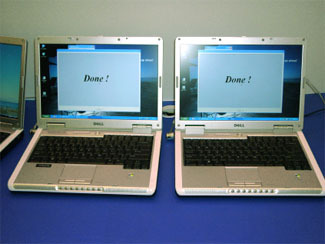Intel's Robson flash technology is impressive, when it works
Taipei (Taiwan) - Intel is promising that its "Robson" technology will cut down computer boot times to as much as half of what they currently stand at. Based on NAND flash memory technology, Robson essentially holds the data one needs to boot an OS or fire up a program, and then accesses it at lightning fast speeds - at least if Intel can get it to work with Windows Vista.
It's a conclusive idea that has been floating around for a while, but it's actually impressive to watch a computer load Windows instantly, albeit after the usual initial boot time. At a demonstration here at Computex in Taipei, the test bed Dell Inspiron 630m machine with Robson inside managed an impressive 30 second start up time.
This initial start up is what Microsoft and Intel are calling "Ready Disk." The other facet of Robson is "Application Boost," which describes a process of flash memory holding program data and boots and runs them from there much faster than normal. We were shown a custom Intel/Microsoft demo on a beta version of Windows Vista in which the system opened up dozens of programs and had them perform multiple tasks. On the normal machine it took 2 minutes and 45 seconds. On the Robson machine it took 1 minute and 10 seconds.
This sounds like heaven to most of us, frustrated by constant delays in turning on and off our computers and loading common applications. To see the entire Office suite spring into action in the blink of an eye nearly brought a tear to my eye. However, there is a hitch with Robson: It doesn't like Windows Vista, which is the only OS on which it will be featured for the time being.
The test bed unit we were shown by Robson project manager William Patterson was running an old beta of Vista, as Robson apparently didn't, and still doesn't, get on too well with Beta 2. It's simply refusing to work on it. Even on the more stable beta we could only manage to get one demonstration to work properly - after three failed attempts. Even on Windows XP, which Robson is being demoed on, but which it will not be featuring as a finished product, the platform had troubles.
The boot test was a fairly straight forward measure of turning on two machines at the same time and looking at our watches, but the more complex ones, such as getting the system to run through a Photoshop time demo, were beyond even Windows XP to do right the first time. Patterson is quite frank in admitting that there remain serious issues with the platform at the moment, mainly heaping the blame on Microsoft, who prepared the demonstrations within Windows. Of course one wouldn't want to get in the middle of a cat fight between those two over whose fault what really is, and so we shall simply say that as it is being demonstrated at the moment, Robson is what it is.
However Patterson is confident that Robson will reach market on time and ready in April next year, presuming of course that we actually have Windows Vista by then. By some small miracle, eh?
Get Tom's Hardware's best news and in-depth reviews, straight to your inbox.
When it does arrive Robson will not be overly expensive, coming in at around $20 for the whole basic package, we're told. That's probably the 256 MB of memory, and one will be able to get Robson also in in 512 MB, 1 GB and 2 GB flavors. "I'd say that 512 will be the sweet spot for the market," Patterson told us. "The more memory you have, the more you can load up. With 256, you'll get the Ready Disk and the most basic bits of Application Boost. Most users in business will go for 512, I'd guess."
At present, Robson will come in either minicard or embedded on the motherboard, and with quite a bit of kit vying for limited minicard space Intel sees many, if not most, opting for the embedded solution. Longer term down the road, Intel thinks about embedding Robson directly onto the southbridge.
Whether or not Apple users will find themselves loading whatever it is Apple users load in the blink of an eye, is another question entirely. We got a "No comment" from Patterson, as Apple is incredibly secretive about what it wants to do in the future, and so Intel is probably better off keeping its mouth shut. However, Patterson did tell us that he didn't see why Robson shouldn't be able to work on Intel-based Macs in the future. I'd bet a bit of my cap that we'll be seeing a tootey fruity version of Robson soon enough.
Intel has about nine months left, if even that, to perfect Robson and make sure that it works with the still unfinished Vista. However it's (paradoxically) definitely something that's worth waiting for.
Related article:
TechEd 2006: Microsoft preps flash-based "performance accelerators" for Vista
(This article was republished from Tom's Hardware's 2006 Computex Coverage)
